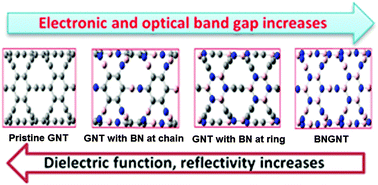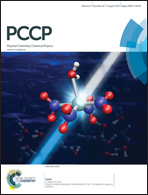Electronic and optical properties of pristine and boron–nitrogen doped graphyne nanotubes†
Abstract
First principle calculations with generalized gradient approximation were carried out to analyse the electronic and optical properties of armchair and zigzag graphyne nanotubes (GNTs). The possible application of these NTs in optoelectronic devices was also investigated. The GNTs were doped with boron (B) and nitrogen (N) atoms and the resulting band gap tuning was studied with respect to the B/N substitution site and increasing diameter of the NTs. The basis of this variation was examined using the partial density of states and crystal orbital Hamilton population analysis. A decreasing trend in the optical response was seen with an increase in the diameter of the NTs. The reported systems showed anisotropic behaviour in the low-energy region. The origin of the optical responses was monitored from the infrared to the UV region depending on the doping site of the B/N. As a result of the large band gap, low reflectivity and low refractive index, B/N GNTs have been established as a suitable system for novel optoelectronic devices. The strong absorption peaks in the UV region mean that they are a good choice for use in UV light protection.


 Please wait while we load your content...
Please wait while we load your content...